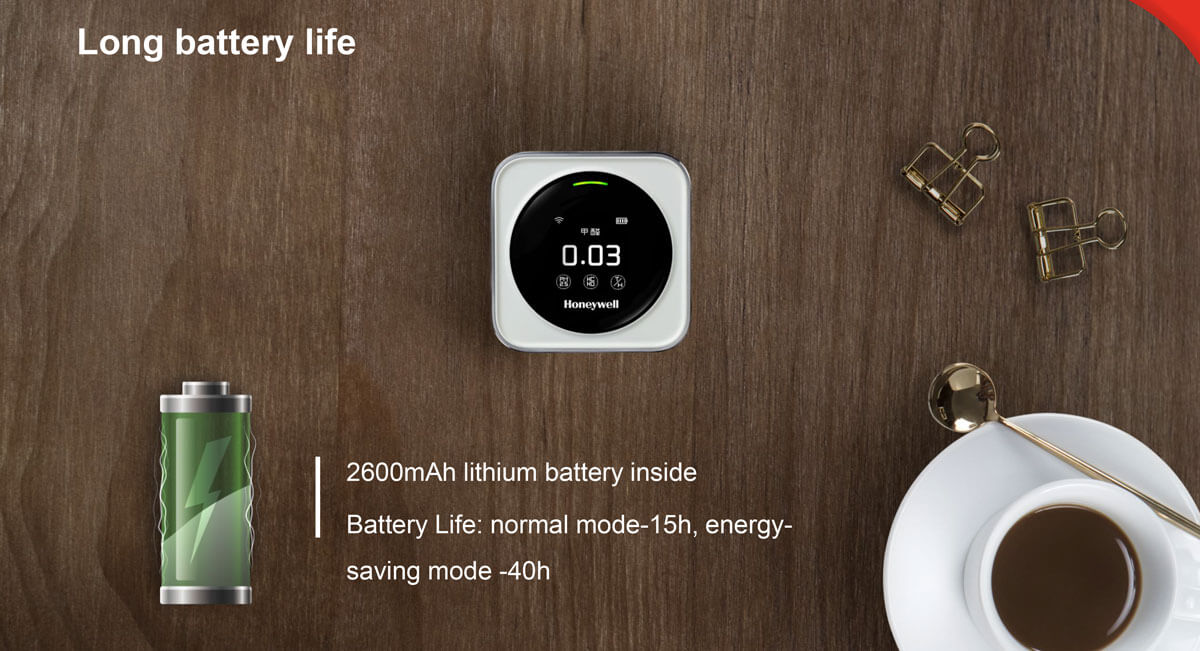The Honeywell Air Quality Monitor can give all the air quality data you may need to know to become a better you. With an award-winning design*, touch screen, color indicators and Wi-Fi connectivity, the device measures six different pollutants, allergens and parameters.
Leveraging a proprietary algorithm, the monitor gives you an IQ percentage reading. It’s a measure of how well your brain can work in the present environment.
When coupled with the connected mobile phone app, you can use it to check ambient air quality anytime, anywhere and take appropriate measures to protect yourself and those you care about.
Air Quality can affect our health, both physical and mental through a variety of pollutants, particulate matter, gases, chemicals and other substances.
See below a full list of the parameters the Honeywell Air Quality Monitor will show and why it’s important to keep track of them.
| INDICATOR | DESCRIPTION | EFFECTS |
| PARTICULATE MATTER (PM2.5) | Particles in the air with a diameter of 0.1 to 2.5 micrometres-this is 3% the diameter of a human hair. It can include soot, combustion byproducts, fossil fuel smoke, cigarette smoke, dust, allergens like pollen and mold, etc... | PM2.5 irritants may lodge in the lungs, causing asthma, respiratory inflammation, aggravated allergies, lung and heart conditions, and maybe carcinogenic after long-term exposure increasing mortality risk. |
| FORMALDEHYDE (HCHO) |
Colorless, flammable and strong-smelling gas released into the air by "off gassing or out gassing" of pressed wood, particlewood and plywood products, wall insulation, some new furniture, glue, adhesive products, etc... | May cause watery eyes; burning sensations in the eyese, nose, and throat, coughing, wheezing, nasuea, skin irritations. Has been recognized as a probable human carcinogen. |
| TOTAL VOLATILE ORGANIC COMPOUNDS (TVOC) | Emitted by a wide array of household products including paints and varnishes, cleaning and disinfecting products; and cosmetics.Concentrations are consistently higher indoors (up to 10 times higher) than outdoors. | May cause eye, nose and throat irritations, headaches, loss of coordination and nausea, damage to the liver, kidney and central nervous system, potential cancer, unknown short-term and long-term adverse effects. |
| CARBON DIOXIDE (CO2) | Colorless and odorless gas produced by burning carbon and organic compounds, and by respiration.Main cause of buildup is poor ventilation. | May cause lack of concentration, dizziness, headache, visual and hearing dysfunction, unconsciousness. |
| HUMIDITY | Water vapors suspended in the air. |
Increased levels may cause excessive mold/fungus and bacteria to grow; decreased levels may cause skin problems, breathing issues, itchy eyes, and aggravated allergic reactions. |
| IQ% | Honeywell developed a proprietary algorithm that can determine the percentage of IQ being used, depending on the quality of the air the person breathes. This does not refer to individual IQ, just to a percentage of total cognitive ability. It varies depending on environmental factors directly impacted by CO2, TVOC and PM2.5 levels.Excellent air environment can raise cognitive ability, and improve various activities. | Lower IQ% levels means your environment may cause poor performance of advanced cognitive functions. |
| INDICATOR | GREEN | ORANGE | RED | DETECTION RANGE |
| PM2.5 | 0 µg/m³ to 79 µg/m³ |
80 µg/m³ to 199 µg/m³ | ≥ 200 µg/m³ | |
| HCHO | <0.08 ppm | >0.08 ppm | 0 ppm to 2 ppm | |
| TVOC | <0.03 ppm | >0.38 ppm | 0.12 ppm to 0.99 ppm | |
| CO₂ | <1000 ppm | >1000 ppm | 400 ppm to 2000 ppm | |
| IQ% | >60% | <60% | 0% to 100% | |
| HUMIDITY | 0% to 100% | |||
| TEMPERATURE | 10℃ to 40℃ [50℉ to 104℉] |

